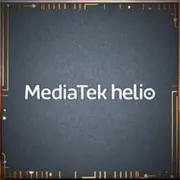MediaTek Helio G70

MediaTek Helio G70: The Budget Champion of 2025?
Overview of capabilities, performance, and use cases
Introduction
In the world of mobile processors, MediaTek has long established itself as a provider of affordable solutions. The Helio G70, released in 2020, remains popular in budget smartphones as of 2025. But how relevant is it now? Let's take a detailed look.
1. Architecture and Manufacturing Process: Basic Operating Principles
Cores and Frequencies
The Helio G70 is built on a hybrid Big.Little architecture with 8 cores:
- 2 high-performance Cortex-A75 cores clocked up to 2 GHz for resource-intensive tasks.
- 6 energy-efficient Cortex-A55 cores clocked at 1.7 GHz for background processes.
The 320 KB L2 cache speeds up data processing, but compared to modern chips (like the Cortex-A78 in Snapdragon 7 Gen 3), this is insufficient for complex computations.
12 nm Manufacturing Process
The 12-nanometer manufacturing process used in the Helio G70 seems archaic today. Modern competitors (e.g., Snapdragon 4 Gen 3) have moved to 6 nm, enhancing energy efficiency and reducing heat. However, for basic tasks, 12 nm still delivers stability.
Mali-G52 MP2 Graphics
The Mali-G52 MP2 GPU, featuring two compute units, supports:
- Resolution up to Full HD+ (1080 × 2520 pixels).
- API Vulkan 1.1 and OpenGL ES 3.2 for mobile gaming.
- Frequencies up to 820 MHz.
This is insufficient for games like Genshin Impact, but it works well for PUBG Mobile or Mobile Legends on medium settings.
2. Real-World Performance: What Can the Helio G70 Do?
Gaming
- PUBG Mobile: Medium settings (HD + 30 FPS) without lag.
- Call of Duty: Mobile: Low/medium settings (40-45 FPS).
- Genshin Impact: Only low settings with frequent drops to 20-25 FPS.
Important: Smartphones with active cooling (e.g., Xiaomi Redmi Note 10) show better stability.
Multimedia
- Video decoding: 4K@30fps (H.264/HEVC).
- Video recording: Up to 1080p@60fps.
- Display support: Full HD+ with a 60 Hz refresh rate.
AI Applications
There is no built-in neural processor (APU). Basic tasks (like background blur in the camera) are executed through CPU/GPU, slowing speed and accuracy. In comparison, Snapdragon 680 utilizes Hexagon 686, accelerating AI operations by 30-40%.
Power Consumption and Heat
With a TDP of 5 watts, smartphones with a 5000 mAh battery can last 1.5-2 days with moderate use. However, under load (gaming, video recording), the chip heats up to 42-45°C, necessitating passive cooling.
3. Integrated Modules: Connectivity and Navigation
4G LTE Modem
- Download speed: Up to 300 Mbps.
- Support for VoLTE, ViLTE.
Wi-Fi and Bluetooth
- Wi-Fi 5 (802.11ac) supporting 2.4/5 GHz ranges.
- Bluetooth 5.0 (A2DP, LE).
Navigation
- GPS, GLONASS, Galileo — a standard set for budget devices.
- A-GPS accelerates location determination in urban settings.
Cons: The lack of 5G and Wi-Fi 6 makes the Helio G70 less relevant in 2025, especially in regions with developed next-generation networks.
4. Comparison with Competitors: Who is Stronger?
MediaTek Helio G70 vs Qualcomm Snapdragon 680
- CPU Performance: Snapdragon 680 (Geekbench 6: Single-Core 450, Multi-Core 1400) is 5-7% faster.
- Graphics: The Adreno 610 in SD 680 is better optimized for gaming.
- Energy Efficiency: The 6 nm process of SD 680 is more economical.
MediaTek Helio G70 vs Unisoc Tiger T610
- AnTuTu 10: Tiger T610 scores around 220,000 points, falling short of Helio G70.
- Camera Support: Both chips work with sensors up to 48 MP, but the Tiger T610 has poorer dynamic range.
Conclusion: Helio G70 is a sweet spot among budget SoCs, but the lack of 5G and outdated manufacturing process reduce its competitiveness.
5. Use Cases: What is the Helio G70 Suitable For?
Gaming
- Recommended for casual games (Candy Crush, Among Us) and competitive titles on low settings.
Daily Tasks
- Social media, messaging, web surfing, streaming video (Netflix, YouTube) — no problems.
Photo and Video
- Main camera: Up to 48 MP with EIS support.
- Video recording: 1080p@60fps.
- Night mode: Works, but with noise and long processing times.
Tip: Choose smartphones with additional cameras (like ultra-wide) to offset the chip’s limitations.
6. Pros and Cons: Is it Worth It?
Advantages:
- Low cost of devices ($150-250).
- Energy efficiency for basic tasks.
- Support for Full HD+ displays.
Disadvantages:
- No 5G and Wi-Fi 6.
- Weak AI features.
- Heating during prolonged loads.
7. Practical Tips: How to Choose a Smartphone with Helio G70?
1. RAM and Storage: At least 4 GB of RAM + 64 GB of storage (better 6/128 GB).
2. Cooling: Models with copper pipes or graphite coatings (e.g., Realme 8i).
3. Screen: IPS with a 60 Hz refresh rate — optimal. AMOLED is rarely found.
4. Battery: At least 5000 mAh for long operation.
5. Updates: Android 13/14 with a promise of 2 years of updates.
Examples of 2025 Devices:
- Xiaomi Redmi 12C: $160, 4/64 GB, 50 MP camera.
- Realme C55: $180, 6/128 GB, 33W fast charging.
8. Final Conclusion: Who is Helio G70 Suitable For?
Target Audience:
- Users who prioritize price over top-tier performance.
- Those not willing to pay for 5G.
- Fans of compact smartphones with long battery life.
Key Benefits:
- Availability.
- Stability in everyday tasks.
- Compatibility with most applications in 2025.
Alternatives: If your budget permits, consider devices with Snapdragon 4 Gen 3 ($200-250) or MediaTek Dimensity 6100+ (5G, $250-300).
Conclusion
The MediaTek Helio G70 in 2025 is an option for those looking for a reliable workhorse without frills. It won't impress with speed, but it offers reliability and savings. However, if you plan to use the smartphone for 3-4 years, it's wise to look at more modern chips with support for 5G and AI accelerators.
Basic
6x 1.7 GHz – Cortex-A55
GPU Specifications
Connectivity
Memory Specifications
Miscellaneous
Benchmarks
Compared to Other SoC
Share in social media
Or Link To Us
<a href="https://cputronic.com/soc/mediatek-helio-g70" target="_blank">MediaTek Helio G70</a>